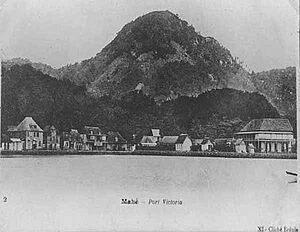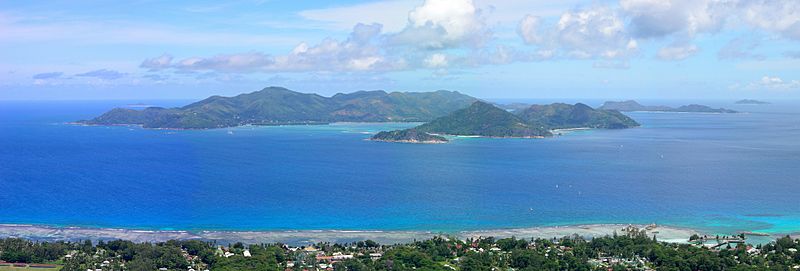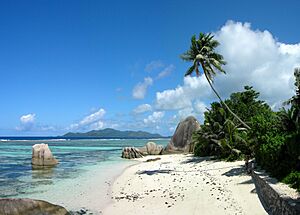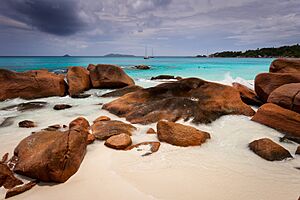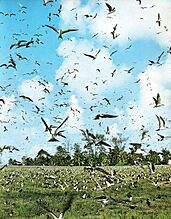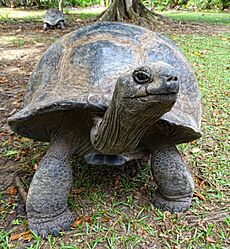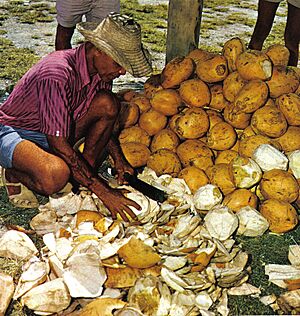Seychelles facts for kids
Quick facts for kids
Republic of Seychelles
|
|
|---|---|
|
|
|
|
Anthem: Koste Seselwa
Join together all Seychellois |
|

Location of Seychelles (dark blue)
– in Africa (light blue & dark grey) |
|
| Capital and largest city
|
Victoria 4°37′S 55°27′E / 4.617°S 55.450°E |
| Official languages | |
| Ethnic groups | Seychellois Creoles others |
| Religion
(2022)
|
|
| Demonym(s) |
|
| Government | Unitary presidential republic |
| Wavel Ramkalawan | |
| Ahmed Afif | |
| Legislature | National Assembly |
| Independence
from the United Kingdom
|
|
|
• Independence declared
|
29 June 1976 |
| Area | |
|
• Total
|
457 km2 (176 sq mi) (181st) |
|
• Water (%)
|
negligible |
| Population | |
|
• 2024 estimate
|
130,523 (200th) |
|
• Density
|
262.3/km2 (679.4/sq mi) (67th) |
| GDP (PPP) | 2023 estimate |
|
• Total
|
|
|
• Per capita
|
|
| GDP (nominal) | 2023 estimate |
|
• Total
|
|
|
• Per capita
|
|
| Gini (2018) | 32.1 medium |
| HDI (2022) | very high · 67th |
| Currency | Seychellois rupee (SCR) |
| Time zone | UTC+04:00 (SCT) |
| Driving side | left |
| Calling code | +248 |
| ISO 3166 code | SC |
| Internet TLD | .sc |
Seychelles is an African country in the Indian Ocean. Its capital city is Victoria. The official languages are Creole, English, and French.
The country is to the east of the African continent. The islands of Madagascar and Mauritius lie to the south. The republic is made up of 115 islands. The biggest part of the population is a mix of freed slaves from the African Continent and Madagascar and European settlers. They make up about 90%. There are small minorities of immigrants from Europe, China and India. Most people are Roman Catholics, about 90% of them. About 8% are Protestants.
Other nearby island countries and territories include Zanzibar to the west, Mauritius, Rodrigues, Agalega and Réunion to the south, and Comoros and Mayotte to the southwest. Seychelles has an estimated population of 86,525. It is the smallest population of any African state.
Contents
History

Seychelles was uninhabited until the 18th century when Europeans arrived with Indians, and enslaved Africans. It remained a British colony from 1814 until its independence in 1976. Seychelles has never been inhabited by indigenous people, but its islanders maintain their own Creole heritage.
Early history
Seychelles was uninhabited throughout most of recorded history, although simulations of Austronesian migration patterns indicate a good probability that Asians visited the islands. Tombs visible until 1910 at Anse Lascars on Silhouette Island have been conjectured to belong to later Maldivian and Arab traders visiting the archipelago. Vasco da Gama and his 4th Portuguese India Armada discovered the Seychelles on 15 March 1503; the first sighting was made by Thomé Lopes aboard Rui Mendes de Brito. Da Gama's ships passed close to an elevated island, probably Silhouette Island, and the following day Desroches Island. Later, the Portuguese mapped a group of seven islands and named them The Seven Sisters. The earliest recorded landing was in January 1609, by the crew of the Ascension under Captain Alexander Sharpeigh during the fourth voyage of the British East India Company.
A transit point for trade between Africa and Asia, the islands were said to be occasionally used by pirates until the French began to take control in 1756 when a Stone of Possession was laid on Mahé by Captain Nicholas Morphey. The islands were named after Jean Moreau de Séchelles, Louis XV's Minister of Finance.
In August 1770, the French ship Thélémaque under the command of Leblanc Lécore landed 28 people—15 white men and 13 enslaved men and women from Africa and India—on Ste. Anne Island.
The British frigate Orpheus commanded by Captain Henry Newcome arrived at Mahé on 16 May 1794, during the War of the First Coalition. Terms of capitulation were drawn up and on the next day, Seychelles was surrendered to the United Kingdom. Jean Baptiste Quéau de Quincy, the French administrator of Seychelles during the years of war with the United Kingdom, declined to resist when armed enemy warships arrived. Instead, he successfully negotiated the status of capitulation to Britain which gave the settlers a privileged position of neutrality.
Britain eventually assumed full control upon the surrender of Mauritius in 1810, formalised in 1814 at the Treaty of Paris. Seychelles became a crown colony separate from Mauritius in 1903. Elections in Seychelles were held in 1966 and 1970.
Independence
In 1976, Seychelles gained independence from the United Kingdom as a republic. It has since become a member of the Commonwealth. In the 1970s Seychelles was "the place to be seen, a playground for film stars and the international jet set". In 1977, a coup d'état by France Albert René ousted the first president of the republic, James Mancham. René discouraged over-dependence on tourism and declared that he wanted "to keep Seychelles for the Seychellois".
The 1979 constitution declared a socialist one-party state, which lasted until 1991.
In the 1980s there were a series of coup attempts against President René, some of which were supported by South Africa. In 1981, Mike Hoare led a team of 43 South African mercenaries masquerading as holidaying rugby players in the 1981 Seychelles coup d'état attempt. There was a gun battle at the airport, and most of the mercenaries later escaped in a hijacked Air India plane. The leader of this hijacking was German mercenary D. Clodo, a former member of the Rhodesian SAS. Clodo later stood trial in South Africa (where he was acquitted) as well as in his home country Germany for air piracy.
In 1986, an attempted coup led by the Seychelles Minister of Defence, Ogilvy Berlouis, caused President René to request assistance from India. In Operation Flowers are Blooming, the Indian naval vessel Vindhyagiri arrived in Port Victoria to help avert the coup.
The first draft of a new constitution failed to receive the requisite 60% of voters in 1992, but an amended version was approved in 1993.
In June 2012, during a conference at the United Nations Conference on Sustainable Development in Rio de Janeiro, a commitment was made by the Seychelles government to protect 30% of its 1.35 million square kilometre marine waters within the country's marine protected areas.
In January 2013, Seychelles declared a state of emergency when the tropical cyclone Felleng caused torrential rain, and flooding and landslides destroyed hundreds of houses.
Following the coup in 1977, the president always represented the same political party until the October 2020 Seychellois general election, which was historic in that the opposition party won. Wavel Ramkalawan was the first president who did not represent United Seychelles (the current name of the former Seychelles People's Progressive Front).
In January 2023, Seychelles announced its final stages of completing its marine spatial plan. It would become the second largest ocean area at 1.35 million km2 (520,000 sq mi) behind Norway, in support of its blue economy.
Geography
An island nation, Seychelles is located in the Somali Sea segment of the Indian Ocean, northeast of Madagascar and about 1,600 km (860 nmi) east of Kenya. The Constitution of Seychelles lists 155 named islands, and a further 7 reclaimed islands have been created subsequent to the publication of the Constitution. The majority of the islands are uninhabited, with many dedicated as nature reserves. Seychelles' largest island, Mahé, is located 1,550 km (835 nmi) from Mogadishu (Somalia's capital).
A group of 44 islands (42 granitic and 2 corallines) occupy the shallow waters of the Seychelles Bank and are collectively referred to as the inner islands. They have a total area of 244 km2 (94 sq mi), accounting for 54% of the total land area of the Seychelles and 98% of the entire population.
The islands have been divided into groups. There are 42 granitic islands known as the Granitic Seychelles. These are in descending order of size: Mahé, Praslin, Silhouette, La Digue, Curieuse, Félicité, Frégate, Ste. Anne, North, Cerf, Marianne, Grand Sœur, Thérèse, Aride, Conception, Petite Sœur, Cousin, Cousine, Long, Récif, Round (Praslin), Anonyme, Mamelles, Moyenne, Ile aux Vaches Marines, L'Islette, Beacon (Ile Sèche), Cachée, Cocos, Round (Mahé), L'Ilot Frégate, Booby, Chauve Souris (Mahé), Chauve Souris (Praslin), Ile La Fouche, Hodoul, L'Ilot, Rat, Souris, St. Pierre (Praslin), Zavé, Harrison Rocks (Grand Rocher).
There are two coral sand cays north of the granitics on the edge of the Seychelles Bank: Denis and Bird. There are two coral islands south of the Granitic: Coëtivy and Platte.
There are 29 coral islands in the Amirantes group, west of the granitic: Desroches, Poivre Atoll (comprising three islands—Poivre, Florentin and South Island), Alphonse, D'Arros, St. Joseph Atoll (comprising 14 islands—St. Joseph, Île aux Fouquets, Resource, Petit Carcassaye, Grand Carcassaye, Benjamin, Bancs Ferrari, Chiens, Pélicans, Vars, Île Paul, Banc de Sable, Banc aux Cocos and Île aux Poules), Marie Louise, Desnœufs, African Banks (comprising two islands—African Banks and South Island), Rémire, St. François, Boudeuse, Étoile, Bijoutier.
There are 13 coral islands in the Farquhar Group, south-southwest of the Amirantes: Farquhar Atoll (comprising 10 islands—Bancs de Sable, Déposés, Île aux Goëlettes, Lapins, Île du Milieu, North Manaha, South Manaha, Middle Manaha, North Island and South Island), Providence Atoll (comprising two islands—Providence and Bancs Providence) and St Pierre.
There are 67 raised coral islands in the Aldabra Group, west of the Farquhar Group: Aldabra Atoll (comprising 46 islands—Grande Terre, Picard, Polymnie, Malabar, Île Michel, Île Esprit, Île aux Moustiques, Ilot Parc, Ilot Émile, Ilot Yangue, Ilot Magnan, Île Lanier, Champignon des Os, Euphrate, Grand Mentor, Grand Ilot, Gros Ilot Gionnet, Gros Ilot Sésame, Héron Rock, Hide Island, Île aux Aigrettes, Île aux Cèdres, Îles Chalands, Île Fangame, Île Héron, Île Michel, Île Squacco, Île Sylvestre, Île Verte, Ilot Déder, Ilot du Sud, Ilot du Milieu, Ilot du Nord, Ilot Dubois, Ilot Macoa, Ilot Marquoix, Ilots Niçois, Ilot Salade, Middle Row Island, Noddy Rock, North Row Island, Petit Mentor, Petit Mentor Endans, Petits Ilots, Pink Rock and Table Ronde), Assumption Island, Astove and Cosmoledo Atoll (comprising 19 islands—Menai, Île du Nord (West North), Île Nord-Est (East North), Île du Trou, Goélettes, Grand Polyte, Petit Polyte, Grand Île (Wizard), Pagode, Île du Sud-Ouest (South), Île aux Moustiques, Île Baleine, Île aux Chauve-Souris, Île aux Macaques, Île aux Rats, Île du Nord-Ouest, Île Observation, Île Sud-Est and Ilot la Croix).
In addition to these 155 islands, as per the Constitution of Seychelles, there are 7 reclaimed islands: Ile Perseverance, Ile Aurore, Romainville, Eden Island, Eve, Ile du Port and Ile Soleil.
South Island, African Banks has been eroded by the sea. At St Joseph Atoll, Banc de Sable and Pelican Island have also eroded, while Grand Carcassaye and Petit Carcassaye have merged to form one island. There are also several unnamed islands at Aldabra, St Joseph Atoll and Cosmoledo. Pti Astove, though named, failed to make it into the Constitution for unknown reasons. Bancs Providence is not a single island, but a dynamic group of islands, comprising four large and about six very small islets in 2016.
Climate
The climate is very humid, as the islands are small, and is classified by the Köppen-Geiger system as a tropical rain forest (Af). The temperature varies little throughout the year. Temperatures on Mahé vary from 24 to 30 °C (75 to 86 °F), and rainfall ranges from 2,900 mm (114 in) annually at Victoria to 3,600 mm (142 in) on the mountain slopes. Precipitation levels are somewhat less on the other islands.
During the coolest months, July and August, the average low is about 24 °C (75 °F). The southeast trade winds blow regularly from May to November, and this is the most pleasant time of the year. The hot months are from December to April, with higher humidity (80%). March and April are the hottest months, but the temperature seldom exceeds 31 °C (88 °F). Most of the islands lie outside the cyclone belt, so high winds are rare.
| Climate data for Victoria (Seychelles International Airport) | |||||||||||||
|---|---|---|---|---|---|---|---|---|---|---|---|---|---|
| Month | Jan | Feb | Mar | Apr | May | Jun | Jul | Aug | Sep | Oct | Nov | Dec | Year |
| Mean daily maximum °C (°F) | 29.8 (85.6) |
30.4 (86.7) |
31.0 (87.8) |
31.4 (88.5) |
30.5 (86.9) |
29.1 (84.4) |
28.3 (82.9) |
28.4 (83.1) |
29.1 (84.4) |
29.6 (85.3) |
30.1 (86.2) |
30.0 (86.0) |
29.8 (85.6) |
| Daily mean °C (°F) | 26.8 (80.2) |
27.3 (81.1) |
27.8 (82.0) |
28.0 (82.4) |
27.7 (81.9) |
26.6 (79.9) |
25.8 (78.4) |
25.9 (78.6) |
26.4 (79.5) |
26.7 (80.1) |
26.8 (80.2) |
26.7 (80.1) |
26.9 (80.4) |
| Mean daily minimum °C (°F) | 24.1 (75.4) |
24.6 (76.3) |
24.8 (76.6) |
25.0 (77.0) |
25.4 (77.7) |
24.6 (76.3) |
23.9 (75.0) |
23.9 (75.0) |
24.2 (75.6) |
24.3 (75.7) |
24.0 (75.2) |
23.9 (75.0) |
24.4 (75.9) |
| Average precipitation mm (inches) | 379 (14.9) |
262 (10.3) |
167 (6.6) |
177 (7.0) |
124 (4.9) |
63 (2.5) |
80 (3.1) |
97 (3.8) |
121 (4.8) |
206 (8.1) |
215 (8.5) |
281 (11.1) |
2,172 (85.6) |
| Average precipitation days (≥ 1.0 mm) | 17 | 11 | 11 | 14 | 11 | 10 | 10 | 10 | 11 | 12 | 14 | 18 | 149 |
| Average relative humidity (%) | 82 | 80 | 79 | 80 | 79 | 79 | 80 | 79 | 78 | 79 | 80 | 82 | 79.8 |
| Mean monthly sunshine hours | 153.3 | 175.5 | 210.5 | 227.8 | 252.8 | 232.0 | 230.5 | 230.7 | 227.7 | 220.7 | 195.7 | 170.5 | 2,527.7 |
| Source 1: World Meteorological Organization | |||||||||||||
| Source 2: National Oceanic and Atmospheric Administration | |||||||||||||
Wildlife
Seychelles is among the world's leading countries to protect lands for threatened species, allocating 42% of its territory for conservation. Like many fragile island ecosystems, Seychelles saw the loss of biodiversity when humans first settled in the area, including the disappearance of most of the giant tortoises from the granitic islands, the felling of coastal and mid-level forests, and the extinction of species such as the chestnut flanked white eye, the Seychelles parakeet, and the saltwater crocodile. However, extinctions were far fewer than on islands such as Mauritius or Hawaii, partly due to a shorter period of human occupation. Seychelles today is known for success stories in protecting its flora and fauna. The rare Seychelles black parrot, the national bird of the country, is now protected.
The freshwater crab genus Seychellum is endemic to the granitic Seychelles, and a further 26 species of crabs and five species of hermit crabs live on the islands. From the year 1500 until the mid-1800s (approximately), the then-previously unknown Aldabra giant tortoise was killed for food by pirates and sailors, driving their numbers to near-extinction levels. Today, a healthy yet fragile population of 150,000 tortoises live solely on the atoll of Aldabra, declared a UNESCO World Heritage Site. Additionally, these ancient reptiles can further be found in numerous zoos, botanical gardens, and private collections internationally. Their protection from poaching and smuggling is overseen by CITES, whilst captive breeding has greatly reduced the negative impact on the remaining wild populations. The granitic islands of Seychelles supports three extant species of Seychelles giant tortoise.
Seychelles hosts some of the largest seabird colonies in the world, notably on the outer islands of Aldabra and Cosmoledo. In granitic Seychelles the largest colonies are on Aride Island including the world's largest numbers of two species. The sooty tern also breeds on the islands. Other common birds include cattle egret (Bubulcus ibis) and the fairy tern (Gygis alba). More than 1,000 species of fish have been recorded.
The granitic islands of Seychelles are home to roughly 268 flowering plant species, of which 70 (28%) are endemic. Particularly well known is the coco de mer, a species of palm that grows only on the islands of Praslin and neighbouring Curieuse. The jellyfish tree is to be found in only a few locations on Mahé. This strange and ancient plant, in a genus of its own, Medusagyne seems to reproduce only in cultivation and not in the wild. Other unique plant species include Wright's gardenia (Rothmannia annae), found only on Aride Island’s Special Reserve. There are several unique species of orchid on the islands. Famous botanist Dr. Herb Herbertson was known for his love of the islands unique orchid varieties.
Seychelles is home to two terrestrial ecoregions: Granitic Seychelles forests and Aldabra Island xeric scrub. The country had a 2019 Forest Landscape Integrity Index mean score of 10/10, ranking it first globally out of 172 countries.
Subdivisions
Seychelles is divided into twenty-five administrative regions. Eight of the districts make up the capital of Seychelles. They are called Greater Victoria. Another 14 districts are considered the rural part of the main island of Mahé. There are two districts on Praslin and one on La Digue which also include satellite islands. The rest of the Outer Islands are not considered part of any district.
|
|
|
Politics
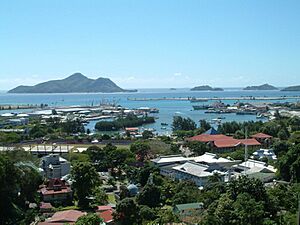
The Seychelles president, who is head of state and head of government, is elected by popular vote for a five-year term of office. The cabinet is presided over and appointed by the president, subject to the approval of a majority of the legislature.
The unicameral Seychellois parliament, the National Assembly or Assemblée Nationale, consists of 35 members, 26 of whom are elected directly by popular vote, while the remaining nine seats are appointed proportionally according to the percentage of votes received by each party. All members serve five-year terms.
The Supreme Court of Seychelles, created in 1903, is the highest trial court in Seychelles and the first court of appeal from all the lower courts and tribunals. The highest court of law in Seychelles is the Seychelles Court of Appeal, which is the court of final appeal in the country.
Economy
During the plantation era, cinnamon, vanilla and copra were the chief exports.
The tourist sector employs about 30% of the labour force. Despite the growth of tourism, farming and fishing continue to employ some people, as do industries that process coconuts and vanilla.
As of 2013[update], the main export products are processed fish (60%) and non-fillet frozen fish (22%).
The prime agricultural products currently produced in Seychelles include sweet potatoes, vanilla, coconuts and cinnamon. These products provide much of the economic support of the locals. Frozen and canned fish, copra, cinnamon and vanilla are the main export commodities.
The national currency of Seychelles is the Seychellois rupee. Initially tied to a basket of international currencies, it was unpegged and allowed to be devalued and float freely in 2008 on the presumed hopes of attracting further foreign investment in the Seychelles economy.
Languages
French and English are official languages along with Seychellois Creole, which is a French-based creole language related to those spoken in Mauritius and Reunion. Seychellois Creole is the most widely spoken native language and de facto the national language of the country. Seychellois Creole is often spoken with English words and phrases mixed in.
Cuisine
Staple foods of Seychelles include fish, seafood and shellfish dishes, often accompanied with rice. Fish dishes are cooked several ways, such as steamed, grilled, wrapped in banana leaves, baked, salted and smoked. Curry dishes with rice are also a significant part of the country's cuisine.
Other staples include coconut, breadfruit, mangoes and kordonnyen fish. Dishes are often garnished with fresh flowers.
- Chicken dishes, such as chicken curry and coconut milk.
- Coconut curry
- Dal (lentils)
- Fish curry
- Saffron rice
- Fresh tropical fruits
- Ladob, eaten either as a savoury dish or as a dessert. The dessert version usually consists of ripe plantain and sweet potatoes (but may also include cassava, breadfruit or even corossol), boiled with coconut milk, sugar, nutmeg and vanilla in the form of a pod until the fruit is soft and the sauce is creamy. The savoury dish usually includes salted fish, cooked in a similar fashion to the dessert version, with plantain, cassava and breadfruit, but with salt used in place of sugar (and omitting vanilla).
- Shark chutney typically consists of boiled skinned shark, finely mashed and cooked with squeezed bilimbi juice and lime. It is mixed with onion and spices, with the onion fried and cooked in oil.
- Vegetables
Images for kids
See also
 In Spanish: Seychelles para niños
In Spanish: Seychelles para niños






